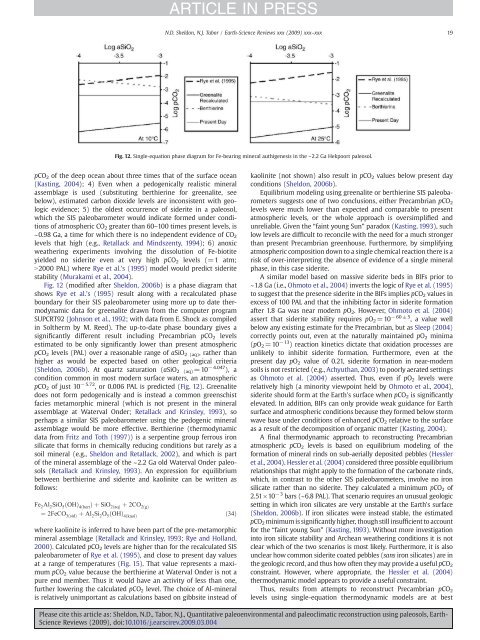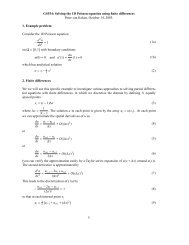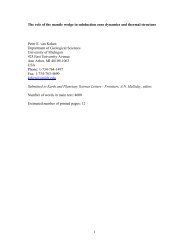Quantitative paleoenvironmental and paleoclimatic reconstruction ...
Quantitative paleoenvironmental and paleoclimatic reconstruction ...
Quantitative paleoenvironmental and paleoclimatic reconstruction ...
Create successful ePaper yourself
Turn your PDF publications into a flip-book with our unique Google optimized e-Paper software.
ARTICLE IN PRESS<br />
N.D. Sheldon, N.J. Tabor / Earth-Science Reviews xxx (2009) xxx–xxx<br />
19<br />
Fig. 12. Single-equation phase diagram for Fe-bearing mineral authigenesis in the ~2.2 Ga Hekpoort paleosol.<br />
pCO 2 of the deep ocean about three times that of the surface ocean<br />
(Kasting, 2004); 4) Even when a pedogenically realistic mineral<br />
assemblage is used (substituting berthierine for greenalite, see<br />
below), estimated carbon dioxide levels are inconsistent with geologic<br />
evidence; 5) the oldest occurrence of siderite in a paleosol,<br />
which the SIS paleobarometer would indicate formed under conditions<br />
of atmospheric CO 2 greater than 60–100 times present levels, is<br />
~0.98 Ga, a time for which there is no independent evidence of CO 2<br />
levels that high (e.g., Retallack <strong>and</strong> Mindszenty, 1994); 6) anoxic<br />
weathering experiments involving the dissolution of Fe-biotite<br />
yielded no siderite even at very high pCO 2 levels (=1 atm;<br />
N2000 PAL) where Rye et al.'s (1995) model would predict siderite<br />
stability (Murakami et al., 2004).<br />
Fig. 12 (modified after Sheldon, 2006b) is a phase diagram that<br />
shows Rye et al.'s (1995) result along with a recalculated phase<br />
boundary for their SIS paleobarometer using more up to date thermodynamic<br />
data for greenalite drawn from the computer program<br />
SUPCRT92 (Johnson et al., 1992; with data from E. Shock as compiled<br />
in Soltherm by M. Reed). The up-to-date phase boundary gives a<br />
significantly different result including Precambrian pCO 2 levels<br />
estimated to be only significantly lower than present atmospheric<br />
pCO 2 levels (PAL) over a reasonable range of aSiO 2 (aq) , rather than<br />
higher as would be expected based on other geological criteria<br />
(Sheldon, 2006b). At quartz saturation (aSiO 2 (aq) =10 − 4.047 ), a<br />
condition common in most modern surface waters, an atmospheric<br />
pCO 2 of just 10 − 5.72 , or 0.006 PAL is predicted (Fig. 12). Greenalite<br />
does not form pedogenically <strong>and</strong> is instead a common greenschist<br />
facies metamorphic mineral (which is not present in the mineral<br />
assemblage at Waterval Onder; Retallack <strong>and</strong> Krinsley, 1993), so<br />
perhaps a similar SIS paleobarometer using the pedogenic mineral<br />
assemblage would be more effective. Berthierine (thermodynamic<br />
data from Fritz <strong>and</strong> Toth (1997)) is a serpentine group ferrous iron<br />
silicate that forms in chemically reducing conditions but rarely as a<br />
soil mineral (e.g., Sheldon <strong>and</strong> Retallack, 2002), <strong>and</strong> which is part<br />
of the mineral assemblage of the ~2.2 Ga old Waterval Onder paleosols<br />
(Retallack <strong>and</strong> Krinsley, 1993). An expression for equilibrium<br />
between berthierine <strong>and</strong> siderite <strong>and</strong> kaolinite can be written as<br />
follows:<br />
Fe 2 Al 2 SiO 5 ðOHÞ 4ðbert<br />
ÞþSiO 2ðaqÞ þ 2CO 2ðgÞ<br />
¼ 2FeCO 3ðsidÞ þ Al 2 Si 2 O 5 ðOHÞ 4ðkaolÞ<br />
ð34Þ<br />
where kaolinite is inferred to have been part of the pre-metamorphic<br />
mineral assemblage (Retallack <strong>and</strong> Krinsley, 1993; Rye <strong>and</strong> Holl<strong>and</strong>,<br />
2000). Calculated pCO 2 levels are higher than for the recalculated SIS<br />
paleobarometer of Rye et al. (1995), <strong>and</strong> close to present day values<br />
at a range of temperatures (Fig. 15). That value represents a maximum<br />
pCO 2 value because the berthierine at Waterval Onder is not a<br />
pure end member. Thus it would have an activity of less than one,<br />
further lowering the calculated pCO 2 level. The choice of Al-mineral<br />
is relatively unimportant as calculations based on gibbsite instead of<br />
kaolinite (not shown) also result in pCO 2 values below present day<br />
conditions (Sheldon, 2006b).<br />
Equilibrium modeling using greenalite or berthierine SIS paleobarometers<br />
suggests one of two conclusions, either Precambrian pCO 2<br />
levels were much lower than expected <strong>and</strong> comparable to present<br />
atmospheric levels, or the whole approach is oversimplified <strong>and</strong><br />
unreliable. Given the “faint young Sun” paradox (Kasting, 1993), such<br />
low levels are difficult to reconcile with the need for a much stronger<br />
than present Precambrian greenhouse. Furthermore, by simplifying<br />
atmospheric composition down to a single chemical reaction there is a<br />
risk of over-interpreting the absence of evidence of a single mineral<br />
phase, in this case siderite.<br />
A similar model based on massive siderite beds in BIFs prior to<br />
~1.8 Ga (i.e., Ohmoto et al., 2004) inverts the logic of Rye et al. (1995)<br />
to suggest that the presence siderite in the BIFs implies pCO 2 values in<br />
excess of 100 PAL <strong>and</strong> that the inhibiting factor in siderite formation<br />
after 1.8 Ga was near modern pO 2 . However, Ohmoto et al. (2004)<br />
assert that siderite stability requires pO 2 =10 − 60 ± 5 , a value well<br />
below any existing estimate for the Precambrian, but as Sleep (2004)<br />
correctly points out, even at the naturally maintained pO 2 minima<br />
(pO 2 =10 − 13 ) reaction kinetics dictate that oxidation processes are<br />
unlikely to inhibit siderite formation. Furthermore, even at the<br />
present day pO 2 value of 0.21, siderite formation in near-modern<br />
soils is not restricted (e.g., Achyuthan, 2003) to poorly aerated settings<br />
as Ohmoto et al. (2004) asserted. Thus, even if pO 2 levels were<br />
relatively high (a minority viewpoint held by Ohmoto et al., 2004),<br />
siderite should form at the Earth's surface when pCO 2 is significantly<br />
elevated. In addition, BIFs can only provide weak guidance for Earth<br />
surface <strong>and</strong> atmospheric conditions because they formed below storm<br />
wave base under conditions of enhanced pCO 2 relative to the surface<br />
as a result of the decomposition of organic matter (Kasting, 2004).<br />
A final thermodynamic approach to reconstructing Precambrian<br />
atmospheric pCO 2 levels is based on equilibrium modeling of the<br />
formation of mineral rinds on sub-aerially deposited pebbles (Hessler<br />
et al., 2004). Hessler et al. (2004) considered three possible equilibrium<br />
relationships that might apply to the formation of the carbonate rinds,<br />
which, in contrast to the other SIS paleobarometers, involve no iron<br />
silicate rather than no siderite. They calculated a minimum pCO 2 of<br />
2.51×10 −3 bars (~6.8 PAL). That scenario requires an unusual geologic<br />
setting in which iron silicates are very unstable at the Earth's surface<br />
(Sheldon, 2006b). If iron silicates were instead stable, the estimated<br />
pCO 2 minimum is significantly higher, though still insufficient to account<br />
for the “faint young Sun” (Kasting, 1993). Without more investigation<br />
into iron silicate stability <strong>and</strong> Archean weathering conditions it is not<br />
clear which of the two scenarios is most likely. Furthermore, it is also<br />
unclear how common siderite coated pebbles (sans iron silicates) are in<br />
the geologic record, <strong>and</strong> thus how often they may provide a useful pCO 2<br />
constraint. However, where appropriate, the Hessler et al. (2004)<br />
thermodynamic model appears to provide a useful constraint.<br />
Thus, results from attempts to reconstruct Precambrian pCO 2<br />
levels using single-equation thermodynamic models are at best<br />
Please cite this article as: Sheldon, N.D., Tabor, N.J., <strong>Quantitative</strong> <strong>paleoenvironmental</strong> <strong>and</strong> <strong>paleoclimatic</strong> <strong>reconstruction</strong> using paleosols, Earth-<br />
Science Reviews (2009), doi:10.1016/j.earscirev.2009.03.004















